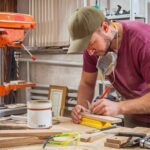Wood moisture plays a crucial role in woodworking, as it can significantly impact the quality and durability of your projects. The best wood moisture for woodworking is essential to ensure that the wood behaves predictably during the crafting process and remains stable over time. Understanding the ideal moisture content for different types of wood is key to producing high-quality pieces that will stand the test of time.
Maintaining the right wood moisture content is vital because it affects the strength, stability, and overall performance of the wood. Too much moisture can lead to warping, cracking, and mold growth, while too little can result in brittleness and difficulty in shaping. By ensuring that your lumber has the correct moisture level before starting a project, you can avoid these potential issues and achieve better results.
In this article, we will delve into the importance of achieving the optimal wood moisture content for woodworking projects. We will explore how incorrect levels can adversely affect your creations and provide insights on how to determine the best wood moisture content for various types of wood.
Additionally, we will discuss tools and techniques for measuring wood moisture, tips for properly drying lumber, common mistakes to avoid when dealing with wood moisture, and best practices for maintaining ideal levels in your workshop.
Importance of the Right Wood Moisture Content
Wood moisture content is a critical factor in woodworking projects, as it directly affects the quality and durability of the final product. The ideal moisture content for woodworking varies depending on the type of wood being used and the specific project at hand. Achieving the best wood moisture for woodworking is essential to prevent issues such as warping, cracking, or shrinking of the wood over time.
Benefits of Proper Wood Moisture Content
Maintaining the correct moisture level in wood not only ensures that your project turns out as intended but also helps to prevent structural damage and deterioration. Wood that is too wet can lead to mold growth, while overly dry wood may become brittle and easily break. By using wood with the optimal moisture content, you can guarantee a smooth woodworking process and end up with a high-quality finished product.
Impact of Incorrect Wood Moisture Levels
When wood is not properly dried or acclimated to its environment before use, it can result in a range of problems during and after the construction process. Excessively moist wood may lead to glue joint failures or uneven finishes due to shrinkage after installation.
On the other hand, overly dry wood can cause joints to loosen or create gaps in the final piece. Understanding and maintaining the best wood moisture for woodworking is crucial for achieving professional results and ensuring long-lasting craftsmanship.
The Effects of Incorrect Wood Moisture Levels on Woodworking Projects
In woodworking, the moisture content of the wood plays a crucial role in the success of a project. Wood that is too wet or too dry can have detrimental effects on the overall quality and durability of the final product. Understanding the effects of incorrect wood moisture levels is essential for any woodworker striving to create high-quality and long-lasting pieces.
Warpage and Shrinkage
One of the most common effects of using wood with incorrect moisture content in woodworking projects is warping and shrinkage. When wood is too wet, it will shrink as it dries, leading to cracks, splits, and deformations in the final piece. Conversely, using wood that is too dry can result in warping as it absorbs moisture from its surroundings. To avoid these issues, it is crucial to use wood with the optimal moisture level for the specific project.
Glue Failure
Another significant consequence of incorrect wood moisture levels is glue failure. When working with wood that is either too wet or too dry, adhesives may not bond properly, leading to weak joints and potential structural problems in the finished piece. It is essential to ensure that both the wood and the glue have compatible moisture levels to achieve strong and durable bonds in woodworking projects.
Mold and Decay
Using wood with high moisture content in woodworking projects can also lead to mold growth and decay over time. Excess moisture creates a favorable environment for mold spores to thrive, causing discoloration, odor, and structural damage to the wood. To prevent mold infestation and decay, it is crucial to select wood with an appropriate moisture level and store it in a controlled environment until ready for use in your woodworking projects.
By understanding how incorrect wood moisture levels can impact woodworking projects, you can take proactive measures to ensure that your creations are structurally sound, aesthetically pleasing, and long-lasting. Paying attention to the best wood moisture for woodworking will lead to improved craftsmanship and overall satisfaction with your finished pieces.
Determining the Best Wood Moisture Content for Different Types of Wood
Wood moisture content varies depending on the type of wood being used in woodworking projects. Different woods have different ideal moisture levels for optimal performance and longevity of the finished product. Here are some recommended wood moisture levels for a few common types of wood used in woodworking:
- Maple: The best wood moisture for woodworking with maple is around 6% to 8%. Too much moisture can cause warping and cracking in maple wood.
- Oak: Oak typically performs best at a moisture content of about 7% to 9%. Higher levels of moisture can lead to difficulties in finishing and shaping oak.
- Pine: The best wood moisture for woodworking with pine ranges from 9% to 14%. This higher range allows pine to remain stable during changes in humidity.
It is important to note that these are general recommendations and may vary depending on your specific woodworking project and environmental conditions. To determine the best wood moisture content for your particular project, it is advisable to use a reliable moisture meter and refer to specific guidelines provided by wood manufacturers or industry experts.
Properly acclimating your wood to the ideal moisture level before beginning a woodworking project can make a significant difference in the quality and durability of the final product. By ensuring that your wood has the correct amount of moisture, you can minimize the risk of issues such as warping, splitting, or glue failure. Remember to always consider the type of wood you are working with and adjust your techniques accordingly to achieve the best results in your woodworking endeavors.
Tools and Techniques for Measuring Wood Moisture
Wood moisture content is a critical factor to consider when working with wood in woodworking projects. Having the right knowledge and tools to measure wood moisture levels accurately can make a significant difference in the quality and durability of your finished pieces. By understanding how to determine the best wood moisture for woodworking, you can ensure that your projects will be successful and long-lasting.
There are various tools and techniques available for measuring wood moisture content accurately. Here are some of the most commonly used methods in woodworking:
- Pin-type moisture meters: These tools use two pins that are inserted into the wood to measure its electrical resistance, providing a reading of the wood’s moisture content.
- Pinless moisture meters: Ideal for measuring thicker pieces of wood without leaving any marks, these meters use electromagnetic technology to scan the surface of the wood and provide a moisture reading.
- Moisture testing kits: These kits often include a combination of probes, sensors, and charts to help determine the moisture content of different types of wood through various testing methods.
Using these tools correctly can help you accurately gauge the moisture levels in your wood before starting any woodworking project. It is essential to remember that different types of wood have varying ideal moisture contents for optimal performance in your projects. By utilizing the right tools and techniques for measuring wood moisture, you can ensure that your projects will turn out beautifully and withstand the test of time.
Tips for Properly Drying Wood for Woodworking Projects
Properly drying wood is essential for any woodworking project to ensure the best results. The moisture content of the wood plays a crucial role in its stability and usability for different applications.
The best wood moisture for woodworking typically falls between 6% to 8%, as this range allows the wood to be easily workable without being too dry or too moist. Wood with the ideal moisture content will also be less prone to warping, cracking, or shrinking once it has been shaped and assembled.
There are several methods you can use to achieve the best wood moisture for woodworking. One common technique is air-drying, where you stack and sticker the wood in a cool, dry area with good airflow. This process can take several months or even years, depending on the thickness of the wood and local humidity levels.
Another method is kiln-drying, which accelerates the drying process using controlled heat and humidity conditions. While this method is faster, it does require specialized equipment and knowledge to prevent over-drying or uneven moisture distribution.
To determine if your wood has reached the optimal moisture content for woodworking, you can use a variety of tools such as a moisture meter or simply rely on visual cues like checking for cracks or listening for a hollow sound when tapping on the wood. Remember that different types of wood may have varying ideal moisture levels, so it’s important to research and adjust your drying methods accordingly.
By properly drying your wood before beginning a project, you can set yourself up for success by working with materials that are stable, easy to manipulate, and less likely to cause issues down the line.
| Wood Drying Method | Time Required |
|---|---|
| Air-Drying | Several months to years |
| Kiln-Drying | Accelerated process with specialized equipment |
Common Mistakes to Avoid When Dealing With Wood Moisture
Wood moisture is a critical factor in woodworking, as it directly impacts the quality and durability of your projects. One common mistake that woodworkers make when dealing with wood moisture is not letting the wood acclimate to the surrounding environment before using it in a project. Wood is hygroscopic, meaning it absorbs and releases moisture depending on its surroundings. If you skip this acclimation process, the wood can expand or contract after assembly, leading to warping, cracking, or splitting.
Another common error is storing wood improperly, which can result in uneven moisture content throughout the piece. For instance, stacking lumber directly on concrete floors can introduce excess moisture to the bottom boards, leading to an imbalance in moisture levels. To prevent this issue, elevate your wood off the ground and store it in a well-ventilated area to promote consistent moisture distribution.
Additionally, failing to use a moisture meter or relying on inaccurate tools for measuring wood moisture can lead to mistakes in woodworking projects. Investing in a high-quality moisture meter designed specifically for wood can help you determine the exact moisture content of your material accurately. By ensuring that you have the right tools and techniques for measuring wood moisture, you will be better equipped to achieve the best wood moisture for woodworking projects.
| Common Mistakes With Wood Moisture | Impact |
|---|---|
| Skipping acclimation process | Warped or cracked wood |
| Improper storage | Uneven moisture content |
| Using inaccurate tools for measuring | Mistakes in projects due to incorrect readings |
Best Practices for Maintaining Optimal Wood Moisture Levels in Your Workshop
In conclusion, maintaining the optimal wood moisture levels in your workshop is crucial for successful woodworking projects. The best wood moisture for woodworking can vary depending on the type of wood being used, but generally falls within a range of 6% to 8%. It is important to understand the effects of incorrect wood moisture levels, as too much or too little moisture can result in warping, cracking, and other issues that can ruin a project.
To ensure you are working with the best wood moisture for woodworking, investing in tools and techniques for measuring wood moisture is essential. Moisture meters are widely available and easy to use, providing accurate readings that can help prevent problems before they arise. Additionally, properly drying wood before starting a project is key to achieving the desired results. This may involve air drying, kiln drying, or other methods depending on the type of wood and its intended use.
By following best practices for maintaining optimal wood moisture levels in your workshop, such as storing wood properly to prevent exposure to excess humidity or dry conditions, you can help prolong the life of your projects and maintain their quality over time. Avoid common mistakes like rushing through the drying process or neglecting to monitor moisture levels regularly. With proper care and attention to detail, you can ensure that your woodworking projects turn out beautifully every time.
Frequently Asked Questions
What Moisture Level Should Wood Be for Woodworking?
The ideal moisture level for woodworking is typically around 6-8%. This level ensures that the wood is stable and won’t warp or shrink after being shaped or cut. Wood with too high a moisture content can be difficult to work with.
What Is the Best Moisture Content for Wood Turning?
For wood turning, a moisture content of around 10-12% is generally recommended. This slightly higher level allows the wood to be more easily turned without cracking or splitting during the process. It strikes a balance between workability and stability in the finished product.
What Is the Best Moisture Content for Burning Wood?
When it comes to burning wood, the best moisture content is below 20%. Wood with higher moisture levels will burn less efficiently, producing more smoke and potentially dangerous creosote buildup in chimneys. Dry wood burns hotter and cleaner, making it safer for use in fireplaces or stoves.

Hi everyone! I’m a woodworker and blogger, and this is my woodworking blog. In my blog, I share tips and tricks for woodworkers of all skill levels, as well as project ideas that you can try yourself.





